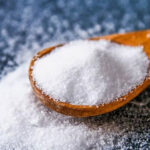Here’s a quick and safe tip to thaw pork without damaging it, as you would with boiling water.
First, take the frozen pork out of the freezer. Instead of rushing to rinse it, sprinkle a thin layer of salt on the surface of the meat. Salt not only enhances the flavor but also helps lower the freezing temperature, aiding in faster thawing.

Start by taking the frozen pork out of the freezer.
Then, gently rub the meat to distribute the salt evenly, almost like a massage to relax the meat fibers and aid in salt absorption. After about a minute, you’ll feel the meat becoming softer and less stiff.

Gently rub the meat to distribute the salt evenly.
Next, place the meat in a small pot and add a little white vinegar. Vinegar will help neutralize any gamey odors and enhance the flavor. Continue by pouring warm water (around 40°C) into the pot, ensuring you don’t use water that’s too hot to avoid losing the meat’s flavor and nutrients. Soak the meat for about 5 minutes, and once it’s more pliable and easier to cut, you can take it out and proceed with your recipe.

Place the meat in a small pot and add a little white vinegar.
If you’re working with a large piece of meat, rinse it twice with water to completely remove any residual salt and vinegar. This step also helps speed up the thawing process. By now, your pork is in an ideal state for cooking, whether you plan to stir-fry, braise, or roast it. All methods will result in delicious and flavorful dishes.
Thawing pork this way not only preserves its shape and flavor during cooking but also safeguards its nutritional content. This method is incredibly simple and easy to execute, even for those who aren’t seasoned cooks.
The Magic of a Cabbage Leaf: Clean Your Range Hood Without the Hassle of Disassembly
Cabbage is a versatile vegetable, often a household staple, and its outer leaves are usually discarded as they tend to be older and less appealing to eat. However, these discarded outer leaves of the cabbage can be your secret weapon in the kitchen! They can be used to effectively clean away grease and grime from your range hood, leaving it sparkling clean.






































